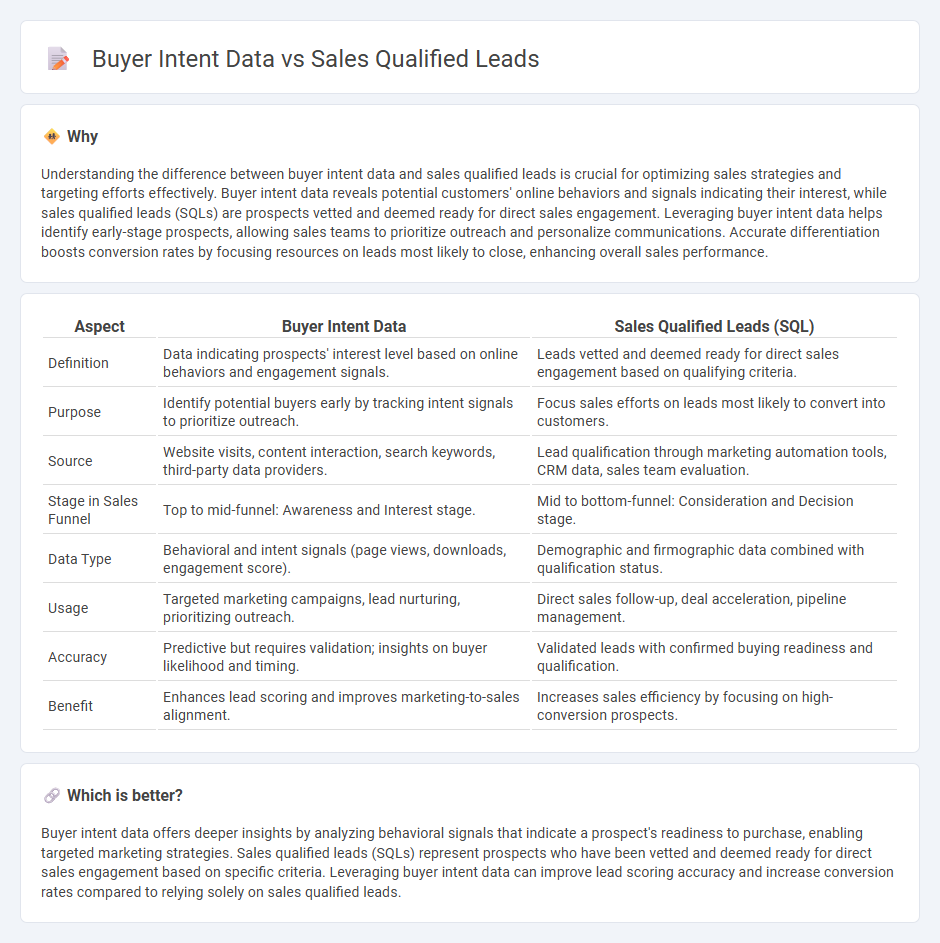
Buyer intent data reveals a prospect's online behavior and signals indicating readiness to purchase, providing sales teams with actionable insights to prioritize leads effectively. Sales qualified leads (SQLs) are prospects vetted through established criteria confirming their potential to convert into customers, ensuring focused and efficient sales efforts. Explore deeper to understand how integrating buyer intent data with SQLs can amplify your sales performance.
Why it is important
Understanding the difference between buyer intent data and sales qualified leads is crucial for optimizing sales strategies and targeting efforts effectively. Buyer intent data reveals potential customers' online behaviors and signals indicating their interest, while sales qualified leads (SQLs) are prospects vetted and deemed ready for direct sales engagement. Leveraging buyer intent data helps identify early-stage prospects, allowing sales teams to prioritize outreach and personalize communications. Accurate differentiation boosts conversion rates by focusing resources on leads most likely to close, enhancing overall sales performance.
Comparison Table
| Aspect | Buyer Intent Data | Sales Qualified Leads (SQL) |
|---|---|---|
| Definition | Data indicating prospects' interest level based on online behaviors and engagement signals. | Leads vetted and deemed ready for direct sales engagement based on qualifying criteria. |
| Purpose | Identify potential buyers early by tracking intent signals to prioritize outreach. | Focus sales efforts on leads most likely to convert into customers. |
| Source | Website visits, content interaction, search keywords, third-party data providers. | Lead qualification through marketing automation tools, CRM data, sales team evaluation. |
| Stage in Sales Funnel | Top to mid-funnel: Awareness and Interest stage. | Mid to bottom-funnel: Consideration and Decision stage. |
| Data Type | Behavioral and intent signals (page views, downloads, engagement score). | Demographic and firmographic data combined with qualification status. |
| Usage | Targeted marketing campaigns, lead nurturing, prioritizing outreach. | Direct sales follow-up, deal acceleration, pipeline management. |
| Accuracy | Predictive but requires validation; insights on buyer likelihood and timing. | Validated leads with confirmed buying readiness and qualification. |
| Benefit | Enhances lead scoring and improves marketing-to-sales alignment. | Increases sales efficiency by focusing on high-conversion prospects. |
Which is better?
Buyer intent data offers deeper insights by analyzing behavioral signals that indicate a prospect's readiness to purchase, enabling targeted marketing strategies. Sales qualified leads (SQLs) represent prospects who have been vetted and deemed ready for direct sales engagement based on specific criteria. Leveraging buyer intent data can improve lead scoring accuracy and increase conversion rates compared to relying solely on sales qualified leads.
Connection
Buyer intent data reveals prospects' behaviors and signals indicating readiness to purchase, enabling sales teams to prioritize and engage effectively. Sales qualified leads (SQLs) emerge when this intent data validates a prospect's fit and likelihood to convert, streamlining the sales funnel. Leveraging buyer intent data enhances lead scoring accuracy, driving higher conversion rates and optimized sales performance.
Key Terms
Lead Scoring
Sales qualified leads (SQLs) represent potential customers who have met specific criteria indicating readiness to purchase, while buyer intent data captures behavioral signals reflecting a prospect's interest level. Lead scoring models integrate both SQL criteria and buyer intent data to prioritize prospects by combining demographic, firmographic, and real-time engagement metrics, thus enhancing sales efficiency. Discover how optimizing lead scoring with these elements can significantly boost conversion rates and revenue growth.
Purchase Signals
Sales qualified leads (SQLs) represent prospects vetted by sales teams based on predefined criteria indicating readiness to buy, while buyer intent data captures behavioral signals such as website visits, content downloads, and product comparisons that reveal active purchase interest. Purchase signals derived from buyer intent data enable marketers to proactively identify high-potential leads before they formally enter the sales funnel, enhancing targeting precision. Explore how integrating intent data with sales qualified leads can optimize your sales strategy and accelerate revenue growth.
Conversion Probability
Sales qualified leads (SQLs) represent individuals or companies that have met specific criteria indicating readiness to engage in a sales process, while buyer intent data captures online behaviors signaling potential purchase interest. Conversion probability increases significantly when leveraging buyer intent data alongside SQLs, as the data enables more precise targeting by identifying prospects actively researching solutions. Explore how integrating buyer intent data enhances your lead qualification process to maximize conversion rates and sales efficiency.
Source and External Links
What is Qualified Lead? | Definition by Insider - A sales qualified lead (SQL) is a potential customer who has shown buying intent, such as requesting a demo or quote, and meets specific criteria like company size and role, indicating readiness for sales outreach.
What is a sales qualified lead (SQL) and why is it important? - An SQL is a lead with a high probability of converting into a customer who has shown clear intent to buy and satisfies qualifying criteria often determined via direct questioning.
Sales-qualified lead (SQL) - Sales-qualified leads are prospective customers who have progressed from marketing qualified leads by demonstrating a strong buying intent and meeting sales team criteria to focus efforts efficiently.
 dowidth.com
dowidth.com